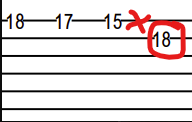That’s awesome — 240 for a minute straight is some real efficiency. It’s great to know that’s possible. I suspect that there are still genetic differences at play in this type of thing, but I also suspect they are probably smaller than what we usually think of. We’ll learn more as more people experiment with these types of motions.
The motion in the bumblebee clip looks like wrist forearm because we see wiggle on every note. But yes, the wrist motion in this case, and in just about all cases of wrist-forearm, as far as I can tell, would be RDT. If I recall there was another clip where it didn’t look like as much wiggle, so there may be some variation in his playing.
Absolutely no judgment intended, this is a great performance. Based on the tutorial video where there is no backing track, I don’t think there is double escape happening here. Any of the usual suspects (displacement, swiping, etc.) are probably what is happening in most of these cases.
There is a great example in the motion tutorial where you can see swiping very clearly but can’t hear it at all:
This was a mistake in the sense that I wasn’t even trying to play that note on the A string, I was just trying to go 0-3-0 on the low string, but picked too far on that note and hit the A instead. And it actually sounds really cool. This is a classic example of how picking techniques evolve and become part of someone’s technique in a more systematic way.
In general, when you do see actual double escape during USX playing it only ever occurs during ascending outside string changes, i.e. a downstroke going to a higher string. Notice that even in this example, that pickstroke is a little different than the others, moving more parallel to the strings instead of rest stroking in a more obviously trapped direction. Sometimes you do see these pickstrokes getting over the string. There are examples of this in the Joscho Stephan interview where he plays ascending sixes and sometimes clears the bar, other times swipes. This is why swiping is effective — it’s not a rest stroke that just powers through the string.
The opposite case, a downstroke going to a lower string, is very unlikely without a helper motion just given that the arm is tilted too far to permit the downstroke to escape.












